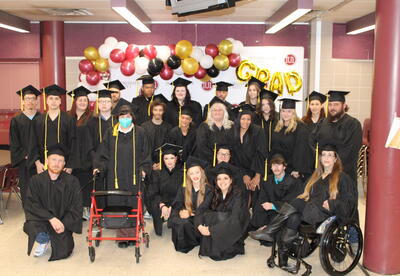Visual Impairment Support
The philosophy of the Intermediate Unit 1 vision support program is that all students who are visually impaired are valuable and important individuals, much more like other children than different from them. The ultimate goal of the vision support program is to prepare students with varying degrees of visual impairment to function as productive members of society.
The Individuals with Disabilities Education Act (IDEA) defines “visual impairment including blindness” as an impairment in vision that, even with correction, adversely affects a child’s educational performance. The term includes both partial sight and blindness.
Vision support services may be direct or indirect in the areas of:
- Concept skills
- Academic skills
- Auditory skills
- Sensory and motor skills
- Orientation and mobility skills
- Career and vocational skills
- Organizational and productivity skills
- Braille skills
- Recreation and leisure skills
- Assistive technology skills
- Social skills
- Independent daily living skills
- Utilization of low vision skills
Assistive Technology
In today’s society, technology plays an important part in the lives of all individuals. For students with visual impairments, the need for assistive technology is of paramount importance in assuring a student’s access to a wide-range of functional, educational, and social opportunities.
The legal definition of an assistive technology device according to IDEA is any item, piece of equipment or product system, whether acquired commercially off the shelf, modified or customized, that is used to increase, maintain, or improve functional capabilities of individuals with disabilities. For students with visual impairments, it also creates a more even “playing field” which permits those students to compete more effectively within the educational setting and with their sighted peers in today’s job market.
In the area of visual impairment assistive technology is divided into two broad categories depending upon the individual’s functional vision capabilities or lack of vision: low vision devices and blindness devices.
Assistive technology may run the continuum from “no tech” environmental adaptations and modifications to “low tech” magnification including magnifiers and large print materials; audio books and tape recorders; use of a cane or the use of a Braille Writer or slate and stylus to “high tech” devices such as modified computer systems, portable note takers, Closed Circuit Television (CCTV), refreshable Braille displays, and reading systems for both low vision and blind students.
The provision of assistive technology is highly individualized and should only be provided after the student has had an assistive technology evaluation. It should be remembered that there is no “best way or best device,” only the one that works best for each student based upon their specific needs in a variety of settings. The goal for each student should be to maximize their independence in all areas of life and to prepare them to be contributing members of society.
Orientation and Mobility Instruction
The Individual with Disabilities Education Act includes orientation and mobility services under the category of “related services”, which are defined as “supportive services as are required to assist a child with a disability to benefit from special education”.
Specifically, according to IDEA, orientation and mobility services are services provided to blind or visually impaired students by qualified personnel to enable those students to attain systematic orientation to and safe movement within their environments in school, home, and community. Orientation and mobility services include teaching students the following, as appropriate: spatial and environmental concepts and use of information received by the senses to establish, maintain or regain orientation and line of travel; to use the long cane to supplement visual travel skills or as a tool for safely negotiating the environment for students with no available travel vision; to understand and use remaining vision and distance low vision aids; and other concepts, techniques, and tools.
As part of the expanded core curriculum, orientation and mobility is a vital area of learning. Both components are necessary for safe and efficient travel within the environment. Orientation involves knowledge of one’s distance and direction relative to things observed or remembered in the surroundings and keeping track of these “self-to-object” spatial relationships as they change during locomotion. Mobility means moving safely, gracefully, and comfortably. Areas of instruction include concept development, gross motor skills, visual efficiency skills, pre-cane and cane skills, orientation techniques and aids, accessing transportation systems, personal safety, and self-advocacy. These skills should be instructed at age-appropriate levels throughout the school years in a variety of indoor and outdoor environments.
Every visually impaired student has the right to an assessment by an orientation and mobility instructor who can determine the student’s instructional needs in the areas of orientation and mobility. Based on the needs identified in the assessment, every visually impaired student has the right to instruction by an orientation and mobility instructor which will lead to the most independent, safe and efficient movement skills, appropriate for each student.
Downloads
- Guidelines for Case Selection, Continuance, and Dismissal of Services for Students with Visual Impairments (PDF Document)
- Referral for Support Services Form
Online Resources
- American Foundation for the Blind
- National Federation of the Blind
- Pittsburgh Vision Services
- Recordings for the Blind and Dyslexic
- Texas School for the Blind and Visually Impaired
- Western Pennsylvania School for Blind Children
- Academy for Certification of Vision Rehabilitation and Education Professionals (ACVREP)
- SharedWork.org
- Bookshare.org
- Braille Rules
- A Guide to Visual Disabilities: How Colleges Help Visually Impaired Students Succeed
- Helping Students with Visual Impairments: Resources, Tools and Technology to Foster School Success
- Visually Disabled Student College Transition Guide
For More Information
For more information about the Vision Impairment Support program at IU1, please contact:
Dr. Kristin J. Szewczyk
Assistant Executive Director/Title IX Coordinator
724-938-3241 ext. 242
kristin.szewczyk@iu1.org
Sara Hoffman
Supervisor of Speech, Vision, and Hearing
724-938-3241 ext. 275
sara.hoffman@iu1.org









